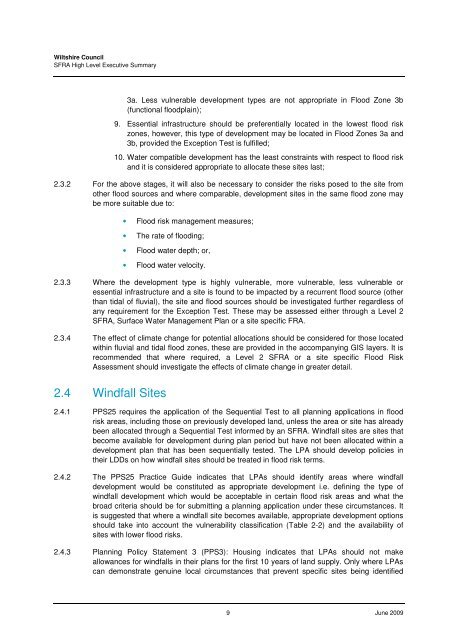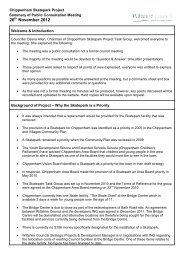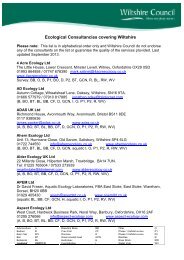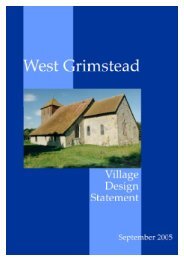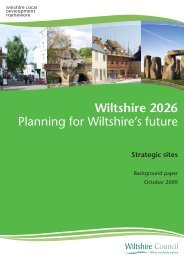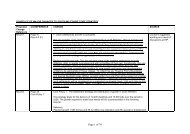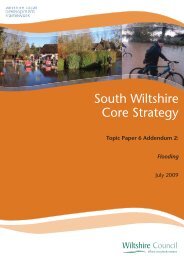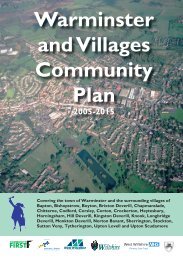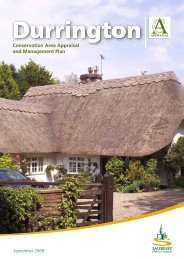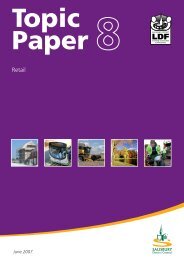Strategic Flood Risk Assessment - Wiltshire Council
Strategic Flood Risk Assessment - Wiltshire Council
Strategic Flood Risk Assessment - Wiltshire Council
Create successful ePaper yourself
Turn your PDF publications into a flip-book with our unique Google optimized e-Paper software.
<strong>Wiltshire</strong> <strong>Council</strong>SFRA High Level Executive Summary3a. Less vulnerable development types are not appropriate in <strong>Flood</strong> Zone 3b(functional floodplain);9. Essential infrastructure should be preferentially located in the lowest flood riskzones, however, this type of development may be located in <strong>Flood</strong> Zones 3a and3b, provided the Exception Test is fulfilled;10. Water compatible development has the least constraints with respect to flood riskand it is considered appropriate to allocate these sites last;2.3.2 For the above stages, it will also be necessary to consider the risks posed to the site fromother flood sources and where comparable, development sites in the same flood zone maybe more suitable due to:• <strong>Flood</strong> risk management measures;• The rate of flooding;• <strong>Flood</strong> water depth; or,• <strong>Flood</strong> water velocity.2.3.3 Where the development type is highly vulnerable, more vulnerable, less vulnerable oressential infrastructure and a site is found to be impacted by a recurrent flood source (otherthan tidal of fluvial), the site and flood sources should be investigated further regardless ofany requirement for the Exception Test. These may be assessed either through a Level 2SFRA, Surface Water Management Plan or a site specific FRA.2.3.4 The effect of climate change for potential allocations should be considered for those locatedwithin fluvial and tidal flood zones, these are provided in the accompanying GIS layers. It isrecommended that where required, a Level 2 SFRA or a site specific <strong>Flood</strong> <strong>Risk</strong><strong>Assessment</strong> should investigate the effects of climate change in greater detail.2.4 Windfall Sites2.4.1 PPS25 requires the application of the Sequential Test to all planning applications in floodrisk areas, including those on previously developed land, unless the area or site has alreadybeen allocated through a Sequential Test informed by an SFRA. Windfall sites are sites thatbecome available for development during plan period but have not been allocated within adevelopment plan that has been sequentially tested. The LPA should develop policies intheir LDDs on how windfall sites should be treated in flood risk terms.2.4.2 The PPS25 Practice Guide indicates that LPAs should identify areas where windfalldevelopment would be constituted as appropriate development i.e. defining the type ofwindfall development which would be acceptable in certain flood risk areas and what thebroad criteria should be for submitting a planning application under these circumstances. Itis suggested that where a windfall site becomes available, appropriate development optionsshould take into account the vulnerability classification (Table 2-2) and the availability ofsites with lower flood risks.2.4.3 Planning Policy Statement 3 (PPS3): Housing indicates that LPAs should not makeallowances for windfalls in their plans for the first 10 years of land supply. Only where LPAscan demonstrate genuine local circumstances that prevent specific sites being identified9 June 2009


